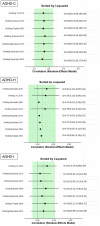Disentangling ADHD's Presentation-Related Decision-Making-A Meta-Analytic Approach on Predominant Presentations
- PMID: 33679462
- PMCID: PMC7930744
- DOI: 10.3389/fpsyt.2021.519840
Disentangling ADHD's Presentation-Related Decision-Making-A Meta-Analytic Approach on Predominant Presentations
Abstract
Background: Deficient decision-making (DM) in attention deficit/hyperactivity disorder (ADHD) is marked by altered reward sensitivity, higher risk taking, and aberrant reinforcement learning. Previous meta-analysis aggregate findings for the ADHD combined presentation (ADHD-C) mostly, while the ADHD predominantly inattentive presentation (ADHD-I) and the predominantly hyperactive/impulsive presentation (ADHD-H) were not disentangled. The objectives of the current meta-analysis were to aggregate findings from DM for each presentation separately. Methods: A comprehensive literature search of the PubMed (Medline) and Web of Science Database took place using the keywords "ADHD," "attention-deficit/hyperactivity disorder," "decision-making," "risk-taking," "reinforcement learning," and "risky." Random-effects models based on correlational effect-sizes were conducted. Heterogeneity analysis and sensitivity/outlier analysis were performed, and publication biases were assessed with funnel-plots and the egger intercept. Results: Of 1,240 candidate articles, seven fulfilled criteria for analysis of ADHD-C (N = 193), seven for ADHD-I (N = 256), and eight for ADHD-H (N = 231). Moderate effect-size were found for ADHD-C (r = 0.34; p = 0.0001; 95% CI = [0.19, 0.49]). Small effect-sizes were found for ADHD-I (r = 0.09; p = 0.0001; 95% CI = [0.008, 0.25]) and for ADHD-H (r = 0.1; p = 0.0001; 95% CI = [-0.012, 0.32]). Heterogeneity was moderate for ADHD-H. Sensitivity analyses show robustness of the analysis, and no outliers were detected. No publication bias was evident. Conclusion: This is the first study that uses a meta-analytic approach to investigate the relationship between the different presentations of ADHD separately. These findings provide first evidence of lesser pronounced impairment in DM for ADHD-I and ADHD-I compared to ADHD-C. While the exact factors remain elusive, the current study can be considered as a starting point to reveal the relationship of ADHD presentations and DM more detailed.
Keywords: attention deficit and hyperactivity disorder; decision making; inattention and hyperactivity; meta-analysis; risk behavior.
Copyright © 2021 Schulze, Coghill, Lux and Philipsen.
Conflict of interest statement
The authors declare that the research was conducted in the absence of any commercial or financial relationships that could be construed as a potential conflict of interest.
Figures





Similar articles
-
A meta-analysis of decision-making and attention in adults with ADHD.J Atten Disord. 2015 May;19(5):355-67. doi: 10.1177/1087054714558872. Epub 2014 Dec 4. J Atten Disord. 2015. PMID: 25477020 Review.
-
Epidemiology of attention-deficit/hyperactivity disorder (ADHD) in children and adolescents in Africa: a systematic review and meta-analysis.Ann Gen Psychiatry. 2020 Mar 13;19:21. doi: 10.1186/s12991-020-00271-w. eCollection 2020. Ann Gen Psychiatry. 2020. PMID: 32190100 Free PMC article. Review.
-
Amphetamines for attention deficit hyperactivity disorder (ADHD) in adults.Cochrane Database Syst Rev. 2018 Aug 9;8(8):CD007813. doi: 10.1002/14651858.CD007813.pub3. Cochrane Database Syst Rev. 2018. PMID: 30091808 Free PMC article.
-
Risky decision making in Attention-Deficit/Hyperactivity Disorder: A meta-regression analysis.Clin Psychol Rev. 2016 Apr;45:1-16. doi: 10.1016/j.cpr.2016.03.001. Epub 2016 Mar 4. Clin Psychol Rev. 2016. PMID: 26978323
-
Childhood ADHD, Going Beyond the Brain: A Meta-Analysis on Peripheral Physiological Markers of the Heart and the Gut.Front Endocrinol (Lausanne). 2022 Mar 1;13:738065. doi: 10.3389/fendo.2022.738065. eCollection 2022. Front Endocrinol (Lausanne). 2022. PMID: 35299964 Free PMC article.
Cited by
-
Cognitive Correlates of Risky Decision-Making in Individuals with and without ADHD: A Meta-analysis.Neuropsychol Rev. 2024 Jun 21. doi: 10.1007/s11065-024-09646-2. Online ahead of print. Neuropsychol Rev. 2024. PMID: 38902592 Review.
-
The Role of Iron and Zinc in the Treatment of ADHD among Children and Adolescents: A Systematic Review of Randomized Clinical Trials.Nutrients. 2021 Nov 13;13(11):4059. doi: 10.3390/nu13114059. Nutrients. 2021. PMID: 34836314 Free PMC article.
-
ADHD traits and financial decision making in stock trading.Sci Rep. 2025 Aug 31;15(1):32011. doi: 10.1038/s41598-025-17467-3. Sci Rep. 2025. PMID: 40887485 Free PMC article.
References
-
- Diagnostic and Statistical Manual of Mental Disorders Fifth Edition . Arlington, VA: American Psychiatric Association; (2013).
-
- Coghill DR, Seth S, Matthews K. A comprehensive assessment of memory, delay aversion, timing, inhibition, decision making and variability in attention deficit hyperactivity disorder: advancing beyond the three-pathway models. Psychol Med. (2014) 44:1989–2001. 10.1017/S0033291713002547 - DOI - PubMed
Publication types
LinkOut - more resources
Full Text Sources
Other Literature Sources

